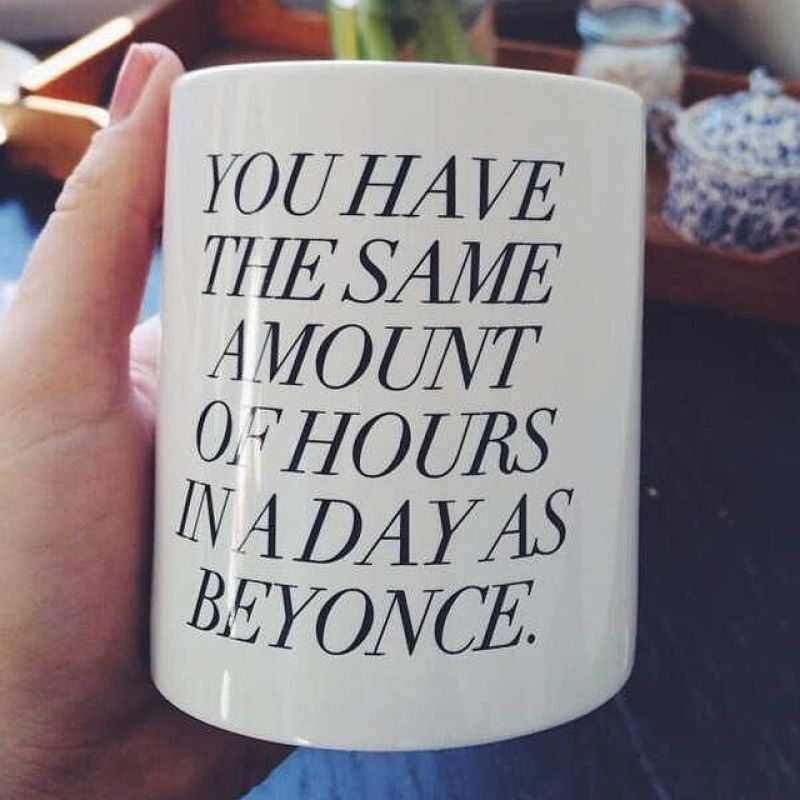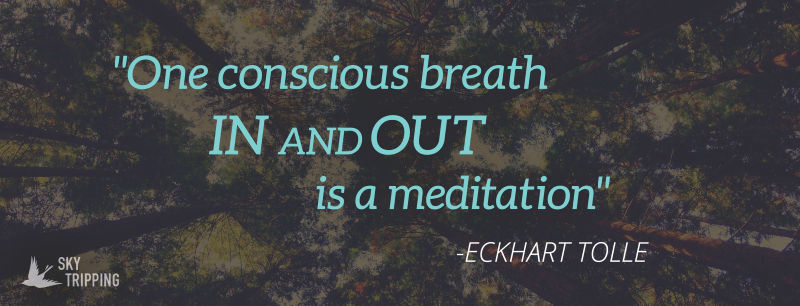NO, BUT SERIOUSLY — I DON’T HAVE TIME TO MEDITATE!

Do you ever find yourself wishing you had more time in your day? Are there habits you want to make room for — healthy things like reading more books, engaging in exercise, taking up a hobby, or practicing regular meditation — but feel there isn’t enough time to spare? Welcome to the club; you’re not alone. In fact, half of all Americans today self-identify as feeling like they have too little time in their day. (At the risk of being a nuisance, I’ll remind you that this means the other half of Americans feel they have time aplenty).

So what separates these two groups: those who feel they have the time they need and those who don’t? Is one half of society really more pushed for time than the other half, or is the old maxim that says, “We all have the same amount of hours in a day as Beyonce” true?
And anyway, is there anything you can actually do if you are constantly fighting the clock?
There’s a fairly simple answer to that question, and probably thousands more covering how you can go about beating your schedule into submission. But today we’re going to explore just one sure-fire solution that anyone can use (but relatively few attempt), and as a bonus we’ll explore the reasons why you’re not already using this simple but powerful tool on a daily basis.
At this point you may be asking, “What’s this magic bullet, this golden goose that has the power to transform my life day in and day out?” The answer is meditation. That’s right: it’s free, it’s simple, and it’s instantly gratifying. Best of all, you can experience the benefits by doing a simple meditation right this minute.
Really.
OUR FIRST 37-SECOND MEDITATION STARTS NOW

Rather than trying to sell you on the incredible benefits of meditation, I would prefer instead to let you experience them for yourself. Right now. Does this scare you? That’s ok! Uncertainty (or even anxiety) is a very common reaction when someone first considers actually exploring meditation. We’ll get into some of the reasons for this common but irrational reaction, but first let’s spend a moment so we can see for ourselves why meditation is a much-needed addition to our day.
37-SECOND MEDITATION: (five measured breaths in and out)
1. Sit in an upright position, stretch and then relax your back and neck, rest your arms and legs (no need to move anywhere, simply stretch and then get into a comfortable but alert position)
2. Exhale, then take a deep, calm breath at an unhurried rate.
3. Once you have filled yourself with breath, calmly exhale and feel the breath leave your body, and allow yourself (mentally and physically) to let it go.
4. Count each inhaled breath, and repeat this process until you have five full inhale/exhale cycles (these will probably take 10-15 seconds each for a full cycle). While you breathe, allow your mind to focus on your breathing. Keep it focused there. If/when your mind wanders, gently bring your concentration back to your breath. You’re not here to solve a problem with your mind, to think about what you need to accomplish, or to tell yourself how you might be able to feel better. You’re here to assist your mind in clearing out some of the excess. You do this by training your mind to stay where you decide it should stay, and right now that means focusing on your breathing. As you slowly inhale and exhale, pay attention to how your body and mind respond to the deliberate slow down, and how it helps you to literally shed the stress and anxiety of the moment. You are taking a moment to heal; it really does work.
How did it go? Pay attention to how your body and mind feel now, and ask yourself, “How did that change my mental and physical state from just a minute or two ago?” Keep in mind that any effects you feel now are likely to be amplified and prolonged the more you practice simple meditations. I’ve found the power and calmness my meditations bring tend to get stronger with time.
YOU NEED MEDITATION. SO WHY ARE YOU LIVING WITHOUT IT?

It’s easy to get carried away on the urgent things in life while at the same time neglecting the important ones. And sometimes things come up that require us to put everything else on hold. But how often do you choose to spend your time on something good at the expense of something better?
Our brains are tricky. We can want (or even want to want) to do something that’s good for ourselves, and yet our own brain can derail our best intentions as if our will were nothing more than an eyelash in a monsoon. It almost seems like we’re helpless prey in the sights of our most dangerous saboteur.
The secret to true, lasting change comes from understanding that the brain is not a single organ, but really two separate parts working in tandem to keep “you” on the right track. Keep in mind, this doesn’t always mean our brain will make the best decisions on our behalf if left unchecked.
There is the autonomic brain, the brain of instinct; and then there’s the intentional brain, the brain of reason. Once you understand that these two parts exist (mostly) independent of each other, then you can start to identify which part of your brain is responsible for your daily decisions — and it’s that “mostly” that is the secret to taking control of your life. I promise, if this isn’t a concept you’ve understood before today, this one piece of information alone will give you incredible power over your life.

Your subconscious brain wants to make sure you feel ok. This means it does really great things for us like making sure we keep breathing, keeping our heart pumping, and setting off automatic alarms when we get hungry. But it also turns dastardly when stresses appear, getting you intoxicated for a quick escape, becoming angry so you get a buzz from the release of adrenaline, or pushing you to tear down others in order to feel superior or “in control”.
Once you recognize that these natural impulses are nothing more than simple means intended to extinguish your discomfort, pain, or even exposure to danger, you can begin to train your mind to anticipate healthier, more positive outlets for relief. Listening to your brain is an important key in this process, as is regularly reminding your subconscious brain that the conscious you is now in charge.
So if you’ve known that meditation brings benefits that can help you be happier (you likely have) and perhaps if you’ve even wanted to start practicing it regularly, why have you failed to make it a habit in your life up to now? Let’s explore some of the most common lies your subconscious might be telling you to keep you back from this healthy change.
LIE #1: YOU CAN HANDLE EVERYTHING THE WAY IT IS NOW
This is a common lie the ego tells us: we can handle our life just the way it is. We don’t need any help. But let’s think about the depth of that illogic for a moment. For example, what attracted you to this article? What kept you reading? I don’t believe in coincidences, but even if they do happen from time to time I’ll be hard-pressed to believe they’re a common occurrence. Something led you to keep reading these words on this post on this day. Is there a reason for that?
Let’s say you do have a perfect handle on everything going on in your life right now, even with zero reflection, meditation, or inner exploration. I would hazard to guess that you sense something is missing — something more. Today is the best time to find out what that is. You may not need it now (I’d challenge that notion), but that doesn’t mean you won’t benefit now. And certainly the regular practice of gentle inward repose will benefit you later in whatever unexpected moment catches you by surprise.
LIE #2: YOU’RE UNCOMFORTABLE WITH THE “YOU” YOU MIGHT DISCOVER
You are the most important person in your life. You have incredible insights that only you can discover within yourself. That’s right, only you will bring the kind of light into the world that you can uniquely offer, but your individuality won’t simply uncover itself — and your best qualities certainly can’t be revealed by others around you, no matter how much they care for you. Are there parts of yourself which you’d rather not acknowledge or face right now? Congratulations! You’ve just discovered that you’re human like all the rest of us! But when you start to accept yourself for who you are — right now — you’ll find it easier than ever to tap into the parts of yourself that you love the most, and learn to accentuate those qualities as you grow into the best person you can be.
We all struggle and falter. That’s part of life. Be gentle with yourself and accept the best you have to offer while acknowledging the other parts that will provide you the opportunity to improve and develop further.
LIE #3: YOU DON’T FEEL WORTHY OF PEACEFULNESS/YOU DON’T HAVE TIME
Let’s be brutally honest for a moment: if you don’t think you’re able to spare thirty-seven measly seconds out of your day to allow calmness to enter into your mind and body, then your schedule isn’t the problem. Perhaps the question you should be asking yourself is, why don’t you want to feel calm? After all, if a few observed breaths can have a measurable impact on your stress levels, then why wouldn’t you take that small moment (or longer) every single day? You’ve already spent 5+ minutes reading this article. In that amount of time, you could have practiced eight meditations like the one we practiced above. If you think time is your problem then you need to think again.
But there’s good news: you’ve already proven that you do have time, and that you are worthy of that care and attention. Set a reminder and commit to yourself now that you will take time every day (even if that means spending 20 seconds to focus on 3 breaths) to help yourself become more centered.
LIE #4: YOU DON’T DIDN’T KNOW HOW
Ta-da! If you’ve read the post up to this point (and exchanged less than a minute of your time to participate in the above meditation), then you know how to meditate. It’s easy to hear the word “meditation” and immediately assume you’re out of your depth. But the reality is, meditation is both a very broad and an insanely simple concept. An effective meditation can take many forms; but at its core, meditation is simply the art of practicing focus. As the dictionary explains,
“Meditation is the act of thinking deeply or focusing one’s mind for a period of time, in silence or with the aid of chanting, for religious or spiritual purposes or as a method of relaxation.”
You don’t need to have any special gadgets, you need zero experience, and it doesn’t even require that you have a specific place set aside for it. As Eckhart Tolle once said, “One conscious breath in and out is a meditation.” If meditation can be something as simple as breathing, then you’ve been practicing your whole life! This can be done literally anywhere, anytime, by anybody.
Of course there are countless things you can do to tailor a meditation to your specific needs, but it should calm your mind to know that getting started — and experiencing powerful, real benefits in the process — requires nothing more than deciding to do it now.

LIE #5: YOU DON’T BELIEVE THERE ARE ANY REAL BENEFITS
This last one seems like it would be reserved for the most skeptical among us, but knowing that the animal brain works so hard to regulate our priorities without us even knowing it, it seems at least reasonable that we show some patience toward the cynic’s hesitation. Hopefully you’ve spent half a minute (or longer!) today trying it for yourself, and have seen that a short moment clearing your mind and relaxing your body can have powerful, lasting effects on your day. But even a skeptic can be dubious of anecdotes, so the logical question we need to answer is whether or not these claimed benefits can be measured and backed by science.
I’m glad you asked. 🙂 A meta-analysis of 163 different studies on the effects of meditation found that meditation has a real, measurable, positive impact on practitioners of meditation. Other studies show that mindfulness meditation can rival pharmaceuticals in effectiveness for treating depression, anxiety, and pain. There are countless other studies that show what a powerful benefit meditation is to the mind and body for those who take the time to practice it. And that’s the catch: you have to do it to tap into these immense benefits.
SEE STUNNING
VIEWS OF EARTH
FROM THE COMFORT
OF YOUR COUCH.

Download Sky Tripping today and experience the peace and tranquility of immersive aerial videos in nature. DOWNLOAD TODAY»
MY PERSONAL TAKEAWAYS
I am no meditation guru by any measure. Like, if we’re being honest, I’m as likely to benefit from writing this article as you are from reading it. I have learned to love and believe in the power of meditation, and have practiced it just enough to know I don’t do it nearly as often as I should. As a result of this article, the Sky Tripping team has started talking about a 30-day challenge to meditate every day and report back with our thoughts and experiences (expect to see a blogpost or 5 about this in the next month or so). But at the end of the day, having the opportunity to explore why I have kept myself from fully enjoying the benefits of meditation on a daily basis has been extremely valuable. I want to meditate. I want to want to meditate. Now I have a better idea of why, despite my desires, I’ve allowed myself to be what holds me back from this powerful tool, and what I can do to overcome that roadblock.
MY CHALLENGE TO YOU

1. Take time for yourself. Recognize that you deserve to take care of your own needs first. Only when you accept that truth will you be fully enabled to help those around you.
2. Personal meditation is just that: personal. Find out what works for you by practicing, exploring, and — when you desire more knowledge — researching what has worked for others. But most importantly, practice! Commit to spending a certain amount of time every day: twenty seconds, two minutes, twenty minutes; one session every morning or two every day — these details don’t matter nearly as much as the fact that you’re actually doing it. You can always improve, refine, and increase. But as they say, starting is half the battle. So start. It really is that simple.
3. Share your experiences with others (including us)! Keeping people in the loop will serve both to help you re-inforce your commitment to yourself, and will also allow you to share something meaningful and helpful with those you care about. The more you discover your own center, the more you’ll find the desire — and the capacity — to help others.
So here’s to increased mindfulness! Sounds off in the comments and let us know how you plan to treat yourself more kindly starting today!

